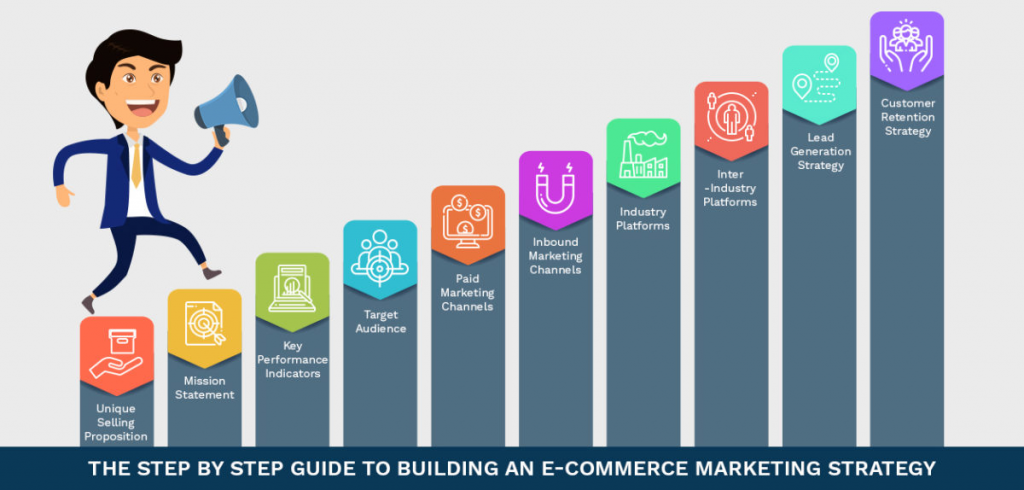
In the magnifying world, we always want to follow the trends. Don’t we? Sometimes, we abide by the trends more than the rules. Whether it be fashion or social media, the trends go viral in the blink of an eye. But which trends are we talking about? No, it’s not fashion or social media. It is e-commerce marketing. Yes, following certain trends in the e-commerce market helps you to adapt better to the changing market segments. With multilateral marketing ways, it is always good to revamp business tactics and strategies. We can rightfully say that not all strategies work for every business. They may vary according to interaction among the consumers, sellers and government. So, before understanding the marketing trends, we must know the e-commerce businesses and the marketing types well.
Classification Of Ecommerce Marketing
The classification of e-commerce marketing according to the business and customer interaction is:
- B2C: Business to consumer
- B2B: Business to business
- C2B: Consumer to business
- C2C: Consumer to consumer
- G2B: Government to business
- B2G: Business to government
- G2C: Government to consumer
E-commerce Marketing Trends
Drones delivering your orders at the doorstep. Facial recognition at the stores. Chatbots. Robots working in the industries. The internet of things. Augmented reality. The future seems so unpredictable and we never know what technological innovation awaits the next moment. As splendid as it seems, the more the competition increases across all digital verticals. The e-commerce trends have wings on them, changing now and then. For every business to sustain, it is essential to keep up with the trends. You need to manage both the back end and front end competencies. Either of these won’t work. Integrate and manage both the operations and design properly. The various market trends across multilateral e-commerce marketing include:
- Augmented reality and online shopping: It serves the purpose of product visualization. With multiple advantages including saving time to shop at stores, price comparison, and product accessibility, AR will be the most viable option in the near future. The possibility of the customers visiting the brick and mortar store decreases with the increase in AR technology. The prediction aims at over 100 million customers using AR by the end of 2020. With the immense potential that AR holds, it will soon become the mainstream method for both small and large businesses replacing the traditional methods of shopping.
- Voice search: Google assistant or Amazon Alexa. Well, you have your personal assistants right at your voice commands. These voice search gadgets aim at making your life simpler, offering comfortable options. It offers immense growth and untapped potential for the e-commerce business. From placing orders to tracking them, it is a plus point to optimize the website well for voice search.
- Artificial Intelligence: Artificial intelligence offers the perfect solution to gain a better insight into the customer’s choices. It offers customers with personalized guidance and product recommendations. You can do this by analysing the search history and their activity on the web. As complex as AI is, it leads to massive increments in social media revenues. The customer expects the brand to care for them and offer them the best. And this, AI does, brings the customers at the priority.
- On-site personalization: Imagine visiting a website and getting all the products of your choice at the home page. Sounds fascinating, right? This is what on-site personalization means. With experiences and marketing strategies, e-commerce marketing tailors the customer’s choices. You can gather the customer-data points, adjusting the web to their needs. This allows better user experience and revenue lift.
- Chatbots: This is an automated programming application that imitates human interaction. Yes, it is like a human interacting and solving your problem in the form of a bot. It allows e-commerce sites to offer solutions to customers 24*7. Chatbots are the customer-oriented solutions developed for spontaneous problem-solving.
- Mobile e-commerce: We spend a lot of our time operating mobile phones, and this is an undeniable fact. Mobile e-commerce bridges the gap between consumers and the need for physical stores. They have clear advantages. If you like something, you can buy it in a few clicks. It is important to optimize mobile applications and websites to provide a user-friendly and seamless experience. The progressive web apps (PWA) also get an ever-increasing response.
- Increased payment methods: The more payment options you offer, the easier it is for the customers to buy the products and services. Mostly, several customers expect the Cash On Delivery (COD) option. This allows the customers to increase trust levels on the brand. It is good to centralize the payment gateway. But without a lengthy procedure and data requirement, using trusted payment providers is good for a minimal friction checkout.
- Subscriptions: Offer subscription services on a budget. The subscriptions benefit both the consumers and retailers. For the retailers, it allows them to segregate the consumer’s requirements. For the consumers, the subscriptions offer additional perks. This further leads to customer retention.
- Sustainable: With the consumers becoming more aware of the global change, they expect the brands to offer sustainable solutions. This means to sustain in the market, offer products that concern the environment and use sustainable practices. Mandatorily add sustainable goals in your business plans.
- Optimization of digital strategies: You always have to deal with competitors in every market segment. You can do this with the help of multi-channel marketing. This helps in conversion optimization. It further helps in gaining potential customers and lead generation. You cannot work on just one strategy. You need to adapt the various strategies for the digital transforming landscape.
- Market automation: Automated concepts are a great way to attract the target audience. About 50% of the businesses are using the market automation strategy and increasing further. The intelligent algorithms allow automatic scheduling of emails, retargeting the potential customers and optimizing websites according to a customer’s search results.
- QR codes: It is a combination of offline and online strategies. You can put the QR codes on the products and even online sites. These QR codes contain special offers and discounts, which make the customers inquisitive to scan them. This allows customer acquisition. It is like a mystery marketing of brands.
- Social marketing: The social media sites are on the trending lists, and so is social media marketing. It is one of the most trusted forms of digital marketing, exploding each day. It is a great way to generate leads and CTR (click-through rate) for your e-commerce sites.
Conclusion
